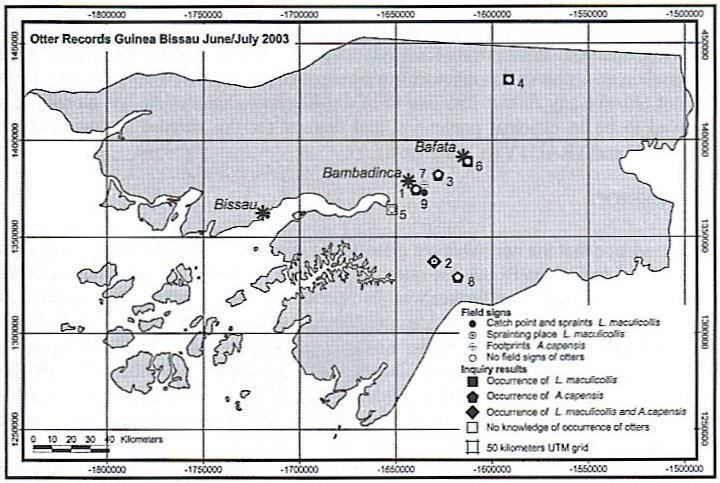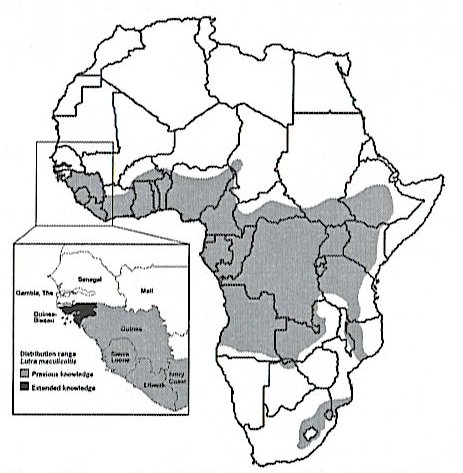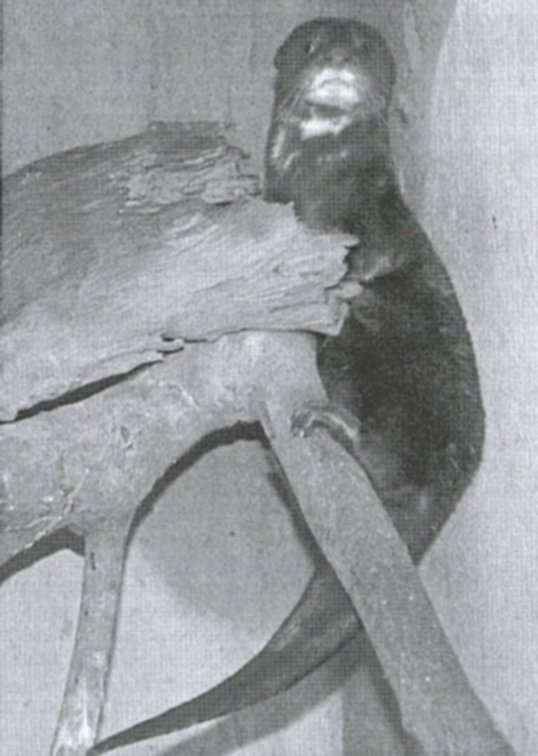 |
Last Update:
Thursday November 22, 2018
|
| [Home] |
|
Volume 20 Issue 1 Pages 1 - 56 (April 2003) Citation: Reuther, C., Ehlers, M., Schumann, M., Kalz, B. and Fickel, J. (2004) New Findings On Otters In Guinea-Bissau. IUCN Otter Spec. Group Bull. 20(1): 19 - 27 New Findings On Otters In Guinea-Bissau Claus Reuther1, Mark Ehlers1, Mario Schuhmann2, Beate Kalz3, Jorns Fickel3 1 Aktion Fischotterschutz
e. V., OTTER-ZENTRUM, 29386 Hankensbüttel, Germany, (received 28th July 2003, accepted 4th September 2003)
INTRODUCTION Knowledge on African otters and their distribution is still limited (REUTHER et al., 2002). Information collected by the coordinators of the IUCN/SSC Otter Specialist Group for Africa, Jan Nel and Hélène Jacques, for the revision of the Otter Action Plan for Africa indicated that the northwestern border of the distribution range of the spotted-necked otter (Lutra maculicollis) was located in Guinea. For the northwestern neighbouring Guinea-Bissau, they received information that only the Cape clawless otter (Aonyx capensis) occurred in this country (FÉRON et al., 1997). N.G. Bias (in litt. 1998 to J. Nel) described the distribution status of this latter otter species as "rare to common; widespread in freshwater systems as well as offshore in the Bijagos archipelago", and he listed as threats "hunted for skins, some locally kept in captivity". The legal status was described as "not protected, hunting forbidden". On April 18th 2003, M. Schuhmann received a live mammal that had been caught in a fishing net by a local fisherman (Figure 3). This mammal was identified as an otter, however, it was clear that it was not the Cape clawless otter. Mrs G. Yoxon of the International Otter Survival fund was contacted for advice, who then passed on the request to J. Nel. Finally C. Reuther, as head of the IUCN Otter Specialist Group (OSG), was contacted and asked for support in identifying this species. Guinea-Bissau is located on the west coast of Africa at around 12° latitude north of the equator, bordered in the west by the Atlantic Ocean, in the north by Senegal and in the east and south by Guinea. The country covers an area of 36,125 km2 and hosts a population of 1.3 million people (36 inhabitants per km2). The coastal areas are flat, with estuaries, mangrove swamps and patches of forest. Inlets indent the coast and high tides periodically submerge the lowest areas, sometimes covering up to a third of the land surface. Inland, the landscape remains flat, with the highest ground, near the Guinean border, just topping 300m above sea level. Numerous meandering rivers cross the country from east to west and form wide estuaries near their mouths. Off the coast is the Arquipélago dos Bijagos, consisting of 18 main islands (FITZPATRICK et al., 2002). The climate is tropical, generally hot and humid. The annual average temperature is around 25°C. The rainy season is from June to November. Annual precipitation is around 2,100mm on average. The few remaining deciduous forests host, among other species, obeche (Triplochiton scleroxylon) and mahagony ssp. (Khaya and Entandrophragma spp). The natural vegetation of most inland areas is lightly wooded savanna, but much of it is under cultivation (rice fields, plantations of cashew nut trees, maize and other crops). In the low-lying coastal zone, with its large creeks, mangroves are the dominant vegetation. On the islands of the Arquipélago dos Bijagos a combination of light woodland and mangroves is dominant. One hundred and twenty eight species of freshwater fishes and 585 species of marine/brackish water fish species are listed for Guinea-Bissau (FROESE and PAULY, 2003). The estuaries of Guinea-Bissau's rivers have an above average species richness (BARAN, 2000). Guinea-Bissau's environment suffers serious degradation, especially from deforestation, soil erosion, overgrazing, and overfishing. Deforestation rate is estimated at up to 48,000 hectares per year, primarily as the result of itinerant agriculture (associated with land clearing and burning). The country's mangroves -some of the most important in Africa - have been destroyed at a rapid pace due to the expansion of rice production (SDIS, 1989). METHODS To identify the animal caught on April 18th 2003, hair (including the root cells) were plucked from the skin and sent to Germany where analysis of DNA was carried out at the Institute for Zoo and Wildlife Research in Berlin. DNA was extracted using the All-tissue DNA kit of GEN-IAL, Germany. A 283 bp fragment of the mitochondrial cytochrome b (cyt b) was amplified using the primers Gludgl and CB2H (KOCHER et al., 1989). Sequences were analysed on an ABI 300 automated sequencer (ABI Biosystems, Germany) and compared with the gene-bank (http://www.ncbi.nlm.nih.gov/). To collect more information on otters in Guinea-Bissau, C. Reuther and M. Ehlers visited the country for an initial field survey from June 26th until July 2 2003. Different types of rivers and wetlands were visited and their banks were investigated for signs of otters. By walking along the banks, footprints and faeces of animals were identified. The location of the survey sites was identified using a Garmin eTrex GPS receiver (GARMIN Inc., USA). The GPS data were processed by the Geographic Information System software ArcView (ESRI, USA) and stored at the 'Information System for Otter Surveys (ISOS)' of Aktion Fischotterschutz (REUTHER et al., 2000). Parallel to the search for field signs, fishermen were interviewed at the different survey sites. For this, the Portuguese translation of the leaflet on African otters (REUTHER et al., 2002) was used. Although many of the fishermen could not read, the photographs hi this leaflet, showing four different otter species, allowed differentiation of the species and an evaluation of the knowledge of the interviewed person. RESULTS The comparison of the DNA analysis of the hairs of the otter caught on April 18 2003 with the gene-bank data yielded a 100% homology to the cyt b sequence of Lutra maculicollis. When C. Reuther and M. Ehlers visited Guinea-Bissau, this otter was kept in an enclosure at the River Zoo Farm, which is located close to the town of Bambadinca (Figure 1). A personal inspection of the otter, and photographs taken by C. Reuther on June 27th 2003, confirmed the species identification. The shape of the head and the white and yellow marks on the throat are identical with those were found on specimens in East Africa. The otter was sexed by M. Schuhmann and found to be a female. Unfortunately, it was not possible to weigh the animal, however, it was estimated to weigh 3-4kg. Together with the phenotype, this indicates that it was a sub-adult animal. Because the rainy season had started unusually early and it rained heavily, access to many rivers and wetlands was limited or impossible. The field survey had to be restricted, therefore, to the central parts of Guinea-Bissau. The heavy rain also limited the possibilities of finding footprints and spraints. Altogether, nine survey sites were investigated, including the site where the otter was caught. At this place, on the Rio Udunduma, fresh spraints of L. maculicollis were found on June 30th 2003, ten weeks after the female otter was caught, indicating that this was not a solitary or migrating individual. Finding typical signs for intensively used dens and rolling sites, found in the root systems of two trees, strengthened this finding. Two other intensively used sprainting sites were found on the Rio Corubal, near the village of Cussilindra in the southern part of Guinea-Bissau, 30km north of the border with Guinea. The spraints, of different ages, were typical L maculicollis spraints (i.e. very similar to L. lutra spraints, being sausage or heap shaped with visible contents (containing fish-scales, bones of fish and amphibians, bird feathers, and crustacean remains); glossy black to dark brown (sometimes greenish) in colour when fresh (reddish if mainly composed of crustaceans); becoming grey to white and breaking up with age; and always with a typical fishy smell. The location of the sprainting sites was very similar to sprainting sites found by C. Reuther in Malawi and in Uganda, being deposited on a rocky island at a prominent place. This island was part of a rocky riverbank and was located between two areas of rapids, more than 100m wide at this site, and showed a reduced velocity of flow between two fast flowing sectors.
Field signs of Aonyx capensis were found at only one survey site. This was in the harbour area of the town of Bambadinca on the Rio Geba. The river here was more than 50m wide and extensively influenced by the tide of the nearby estuary. At low water level footprints of one individual of A. capensis were found on the wide muddy riverbank. In most cases, the consultation of local fishermen seemed to produce reliable results when asked to identify the otter species they had observed using photographs. However, a few of them identified Lutra lutra as a species they believed to be occurring in their region. Though such inquiry results have to be used with great care, they indicate that both species, L. maculicollis and A. capensis, have been observed on the Rio Corubal as well as on the Rio Geba. From his own observations, and on the basis of previous reports from local people, M. Schumann assumes that A. capensis is widespread over most of the country, even on the islands of the Bijagos archipelago. M. Schuhmann, who was responsible for the government zoo in Bissau from 1993 until 1998, contributed additional historic information. During this period, several otter cubs were brought to the zoo and were successfully handraised. Those cubs, which were documented by photographs, could be clearly identified by C. Reuther as A. capensis. From his experience with raising cubs of A. capensis M. Schuhmann could report that several of them died because of a heartworm infection (dirofilariosis). This disease is caused by a nematode worm and transmitted by mosquitoes. Its occurrence is also known for parts of West Africa (SCHREY and TRAUTVETTER, 1998). After using Ivermeticin as a preventive measure for newly arriving orphaned cubs M. Schumann did not observe any further loss due to of dirofilariosis. Ivermeticin has already been prooved to be an efficient prevention and therapy for this disease in dogs and cats (SCHREY and TRAUTVETTER, 1998). DISCUSSION With evidence that the northwestern distribution range of L. maculicollis now needs to be extended to Guinea-Bissau the question arises as to whether its distribution border might not be located more further west and north. The next northern river systems are those of the Casamance River in southern Senegal, the Gambia River in The Gambia, and the Senegal River on the border between Senegal and Mauritania and Mali. For these rivers, the occurrence of only A. capensis is reported (DUPUIS, 1972, GRUBB et al., 1998, SILLERO-ZUBIRI and MARINO, 1997). More detailed field surveys need to be carried out to evaluate this information and to try to find evidence of the occurrence of L. maculicollis. For Guinea-Bissau, it will not be enough to add this species to the list of native mammal species. The distribution status of both otter species will need a complete revision. As a first step, an inquiry among the local fishermen might give initial information. One problem connected with this method is that the local people do not have different terms for the two otter species; in the different languages in use in Guinea-Bissau there is only one word for otter. In Crioulo this is 'lontri', in Fula 'djira uluru', in Balanta 'nam.nine', and in Mandinga 'dji.ulo'. Therefore, the use of photographs of different species is unavoidable. However, as is well known and could be proved again during this survey, even information based on photographs needs to be handled with great care. For instance, doubts are advisable if fishermen declare that they have observed otters exclusively by night, but allege that they can identify the species, something that is difficult even for specialists in otters. Another example of the low reliability of information from local people arose during this visit to Guinea-Bissau, when a skin of a mammal was presented as being A. capensis. Through the DNA analysis of a hair sample of this fur the species could be identified as a carnivore, probably a honey badger (Mellivora capensis). A more specific identification was not possible, because of the missing reference samples in the gene bank. However, there was no evidence that this skin originated from A. capensis or even from L. maculicollis. Therefore, field surveys using direct observations, footprints and spraints as evidence for the species identification will be unavoidable if the distribution status is to be investigated. An important aspect of such surveys should be the question of whether there is a difference in habitat structure or food-niche that could form the basis for a differentiation of distribution range. The results of the current survey seem to indicate that A. capensis might be found mainly in the tidal areas of the coasts, estuaries and rivers, where crustaceans are abundant, or in wetlands with ponds that are rich in amphibians, whereas L. maculicollis is mainly found in fast flowing and/or clear rivers where fish are the dominant prey. This would confirm similar findings found in the KwaZulu-Natal Drakensberg area in South Africa (PERRIN and CARUGATI, 2000a,b). However, data from this survey are too limited to enable more than a hypothesis.
Information on the distribution range of the two otter species is also needed as a basis to define the conservation needs for otters in Guinea-Bissau. As was reported by several fishermen, it is not unusual that otters are drowned in fishnets. Improving knowledge of the circumstances of such accidents (kind and position of the nets, structures of habitats, species, sex and age of the otters, etc.) could contribute to a development of protection measures, if such would be accepted by the fishermen. The problem seems to be that otters in Guinea-Bissau are not hunted for skins, as was reported by N.G. Bias (in litt. 1998) to J. Nel and H. Jacques, but for their meat. M. Schuhmann has evidence that otters are eaten and, in a local community visited during this survey, remains of an otter's fur were shown which which had been buried as as it was considered useless, as well as another of which only small pieces had been used for a belt that was used to keep away an evil spirit. Officially, hunting of otters is not allowed in Guinea-Bissau but it seems that nobody cares. Specific protection of otters is only recommended by the administration, but not legally fixed by the government (F. Djedjo, pers. cornm.). Because the status of otters in Guinea-Bissau is not clarified, such legal protection seems to be necessary immediately, especially if Guinea-Bissau forms the north-western border of the distribution range of L maculicollis.
Acknowledgements - Mrs. Grace Yoxon of the International Otter Survival Fund is thanked for passing on Mr. Schuhmann's original enquiry about the identity of the otter he received. Prof. Jan Nel kindly assisted in the identification process for this otter. The staff of the Institute for Zoo and Wildlife Research (IZW) in Berlin are thanked for carrying out the DNA analysis. Mr. Fai Djedjo of the Direccao Geral das Florestas is thanked for his assistance in the field and in undertaking enquiries with fishermen and local people. Anna Krekemeyer prepared the GIS data and the map with the survey results whilst Matthias Hofmann prepared the distribution map. The German Association for Otter Conservation [Aktion Fischotterschutz] financed the DNA analyses and the field survey. REFERENCES Baran, E. 2000. Biodiversity of Estuarine
Fish Faunas in West Africa. Naga. The ICLARM Quarterly 23/4, Résumé : Nouvelles Données sur les Loutres
en Guinée-Bissau Resumen: Nuevos Hallazgos de Nutrias
en Guinea-Bissau |
| [Copyright © 2006 - 2050 IUCN/SSC OSG] | [Home] | [Contact Us] |


